FIAT BRAVO 2008 2.G Owners Manual
Manufacturer: FIAT, Model Year: 2008, Model line: BRAVO, Model: FIAT BRAVO 2008 2.GPages: 246, PDF Size: 4.01 MB
Page 201 of 246
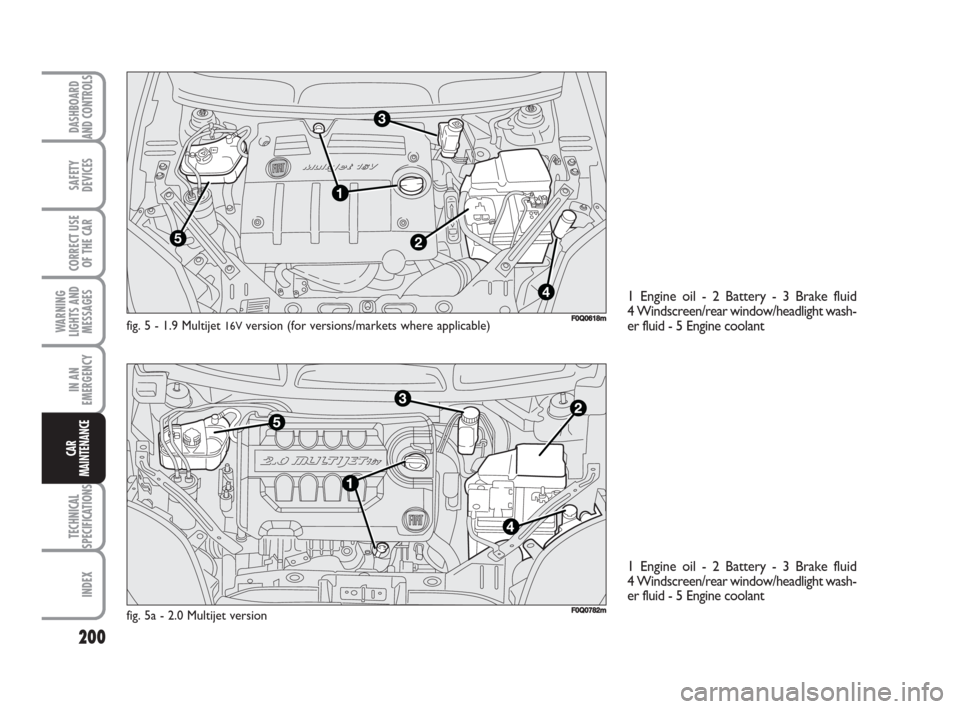
200
SAFETY
DEVICES
CORRECT USE
OF THE CAR
WARNING
LIGHTS AND
MESSAGES
IN AN
EMERGENCY
TECHNICAL
SPECIFICATIONS
INDEX
DASHBOARD
AND CONTROLS
CAR
MAINTENANCE
2
3
4
5
1
FF0Q0618mfig. 5 - 1.9 Multijet 16V version (for versions/markets where applicable)
1 Engine oil - 2 Battery - 3 Brake fluid
4 Windscreen/rear window/headlight wash-
er fluid - 5 Engine coolant
fig. 5a - 2.0 Multijet version F0Q0782m
1 Engine oil - 2 Battery - 3 Brake fluid
4 Windscreen/rear window/headlight wash-
er fluid - 5 Engine coolant
191-212 BRAVO GB 29-10-2008 12:33 Pagina 200
Page 202 of 246
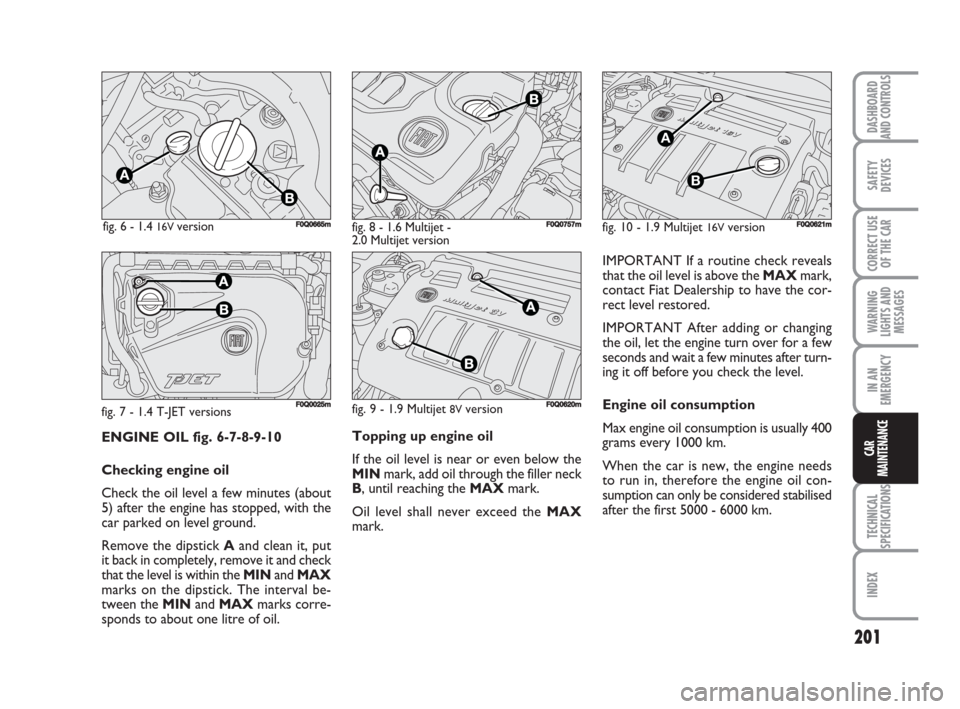
201
SAFETY
DEVICES
CORRECT USE
OF THE CAR
WARNING
LIGHTS AND
MESSAGES
IN AN
EMERGENCY
TECHNICAL
SPECIFICATIONS
INDEX
DASHBOARD
AND CONTROLS
CAR
MAINTENANCEENGINE OIL fig. 6-7-8-9-10
Checking engine oil
Check the oil level a few minutes (about
5) after the engine has stopped, with the
car parked on level ground.
Remove the dipstick Aand clean it, put
it back in completely, remove it and check
that the level is within the MINand MAX
marks on the dipstick. The interval be-
tween the MINand MAXmarks corre-
sponds to about one litre of oil.
F0Q0665m
Topping up engine oil
If the oil level is near or even below the
MINmark, add oil through the filler neck
B, until reaching the MAXmark.
Oil level shall never exceed the MAX
mark.
F0Q0620m
fig. 10 - 1.9 Multijet 16V version
A
B
F0Q0621m
IMPORTANT If a routine check reveals
that the oil level is above the MAXmark,
contact Fiat Dealership to have the cor-
rect level restored.
IMPORTANT After adding or changing
the oil, let the engine turn over for a few
seconds and wait a few minutes after turn-
ing it off before you check the level.
Engine oil consumption
Max engine oil consumption is usually 400
grams every 1000 km.
When the car is new, the engine needs
to run in, therefore the engine oil con-
sumption can only be considered stabilised
after the first 5000 - 6000 km.
F0Q0025mfig. 7 - 1.4 T-JET versions fig. 6 - 1.4
16V version
fig. 9 - 1.9 Multijet
8V version fig. 8 - 1.6 Multijet -
2.0 Multijet version
F0Q0757m
191-212 BRAVO GB 29-10-2008 12:33 Pagina 201
Page 203 of 246
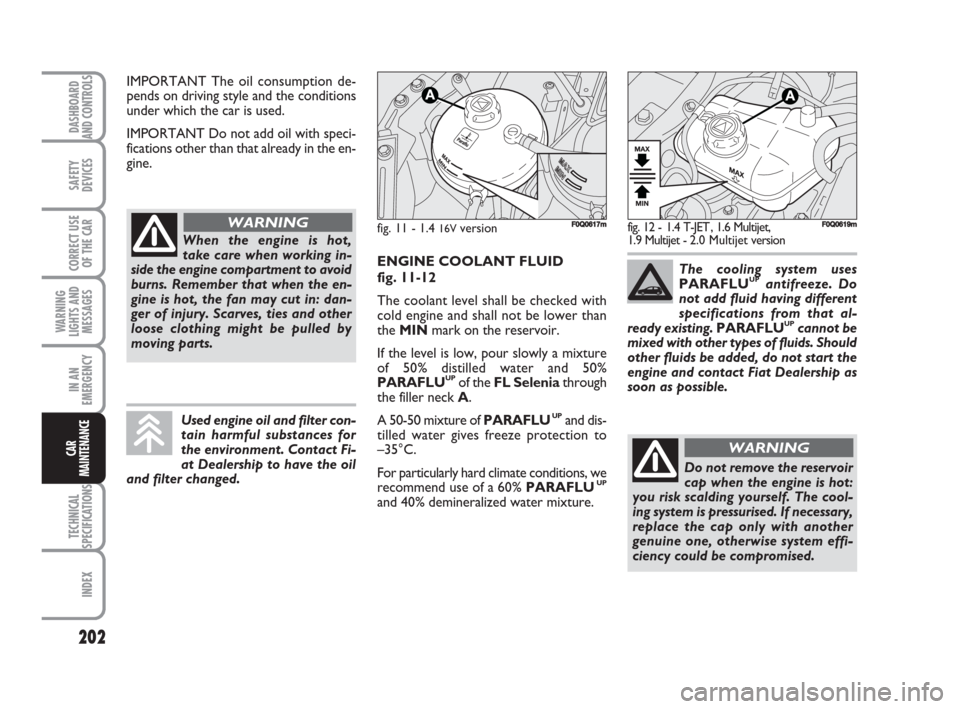
202
SAFETY
DEVICES
CORRECT USE
OF THE CAR
WARNING
LIGHTS AND
MESSAGES
IN AN
EMERGENCY
TECHNICAL
SPECIFICATIONS
INDEX
DASHBOARD
AND CONTROLS
CAR
MAINTENANCE
IMPORTANT The oil consumption de-
pends on driving style and the conditions
under which the car is used.
IMPORTANT Do not add oil with speci-
fications other than that already in the en-
gine.
WARNING
Used engine oil and filter con-
tain harmful substances for
the environment. Contact Fi-
at Dealership to have the oil
and filter changed.
ENGINE COOLANT FLUID
fig. 11-12
The coolant level shall be checked with
cold engine and shall not be lower than
the MINmark on the reservoir.
If the level is low, pour slowly a mixture
of 50% distilled water and 50%
PARAFLU
UPof the FL Seleniathrough
the filler neck A.
A 50-50 mixture of PARAFLU
UPand dis-
tilled water gives freeze protection to
–35°C.
For particularly hard climate conditions, we
recommend use of a 60% PARAFLU
UP
and 40% demineralized water mixture.
fig. 11 - 1.4 16V version F0Q0617mfig. 12 - 1.4 T-JET , 1.6 Multijet,
1.9 Multijet - 2.0 MultijetversionF0Q0619m
The cooling system uses
PARAFLUUPantifreeze. Do
not add fluid having different
specifications from that al-
ready existing. PARAFLU
UPcannot be
mixed with other types of fluids. Should
other fluids be added, do not start the
engine and contact Fiat Dealership as
soon as possible.
Do not remove the reservoir
cap when the engine is hot:
you risk scalding yourself. The cool-
ing system is pressurised. If necessary,
replace the cap only with another
genuine one, otherwise system effi-
ciency could be compromised.
WARNING
When the engine is hot,
take care when working in-
side the engine compartment to avoid
burns. Remember that when the en-
gine is hot, the fan may cut in: dan-
ger of injury. Scarves, ties and other
loose clothing might be pulled by
moving parts.
191-212 BRAVO GB 29-10-2008 12:33 Pagina 202
Page 204 of 246
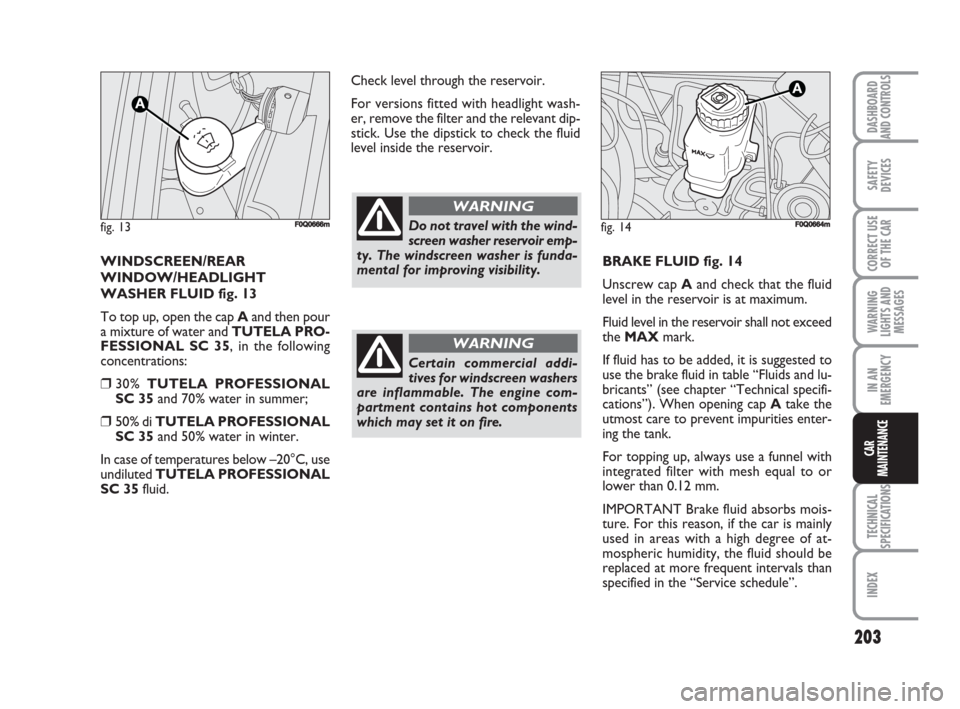
203
SAFETY
DEVICES
CORRECT USE
OF THE CAR
WARNING
LIGHTS AND
MESSAGES
IN AN
EMERGENCY
TECHNICAL
SPECIFICATIONS
INDEX
DASHBOARD
AND CONTROLS
CAR
MAINTENANCE
WINDSCREEN/REAR
WINDOW/HEADLIGHT
WASHER FLUID fig. 13
To top up, open the cap Aand then pour
a mixture of water and TUTELA PRO-
FESSIONAL SC 35, in the following
concentrations:
❒30% TUTELA PROFESSIONAL
SC 35and 70% water in summer;
❒50% di TUTELA PROFESSIONAL
SC 35and 50% water in winter.
In case of temperatures below –20°C, use
undiluted TUTELA PROFESSIONAL
SC 35 fluid.
fig. 13F0Q0666mDo not travel with the wind-
screen washer reservoir emp-
ty. The windscreen washer is funda-
mental for improving visibility.
WARNING
Certain commercial addi-
tives for windscreen washers
are inflammable. The engine com-
partment contains hot components
which may set it on fire.
WARNING
BRAKE FLUID fig. 14
Unscrew cap Aand check that the fluid
level in the reservoir is at maximum.
Fluid level in the reservoir shall not exceed
the MAXmark.
If fluid has to be added, it is suggested to
use the brake fluid in table “Fluids and lu-
bricants” (see chapter “Technical specifi-
cations”). When opening cap Atake the
utmost care to prevent impurities enter-
ing the tank.
For topping up, always use a funnel with
integrated filter with mesh equal to or
lower than 0.12 mm.
IMPORTANT Brake fluid absorbs mois-
ture. For this reason, if the car is mainly
used in areas with a high degree of at-
mospheric humidity, the fluid should be
replaced at more frequent intervals than
specified in the “Service schedule”.
fig. 14F0Q0664m
Check level through the reservoir.
For versions fitted with headlight wash-
er, remove the filter and the relevant dip-
stick. Use the dipstick to check the fluid
level inside the reservoir.
191-212 BRAVO GB 29-10-2008 12:33 Pagina 203
Page 205 of 246
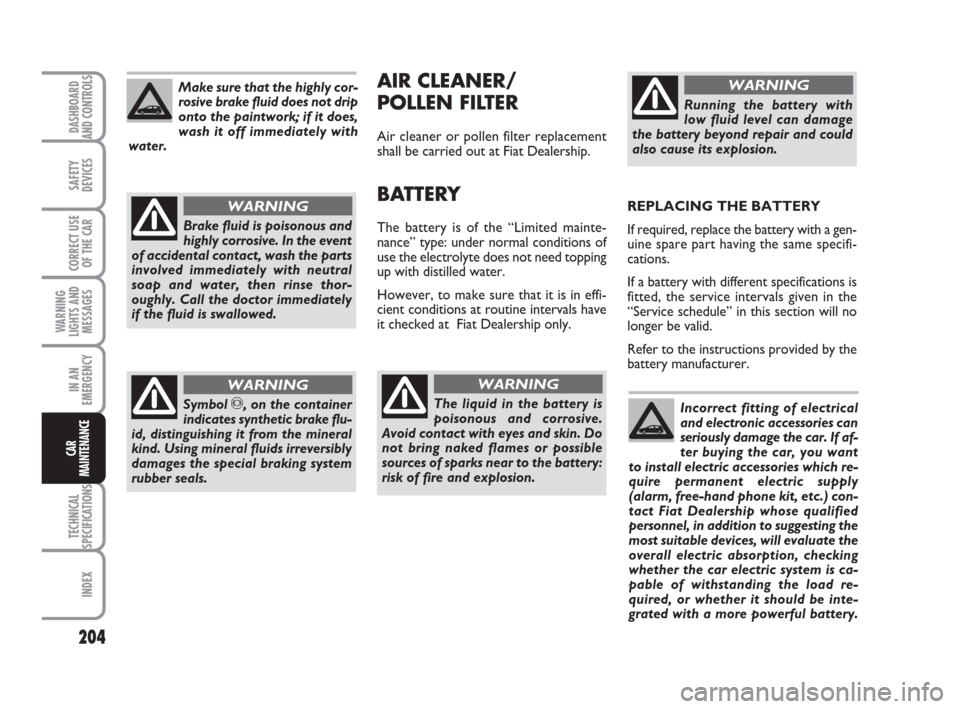
204
SAFETY
DEVICES
CORRECT USE
OF THE CAR
WARNING
LIGHTS AND
MESSAGES
IN AN
EMERGENCY
TECHNICAL
SPECIFICATIONS
INDEX
DASHBOARD
AND CONTROLS
CAR
MAINTENANCE
REPLACING THE BATTERY
If required, replace the battery with a gen-
uine spare part having the same specifi-
cations.
If a battery with different specifications is
fitted, the service intervals given in the
“Service schedule” in this section will no
longer be valid.
Refer to the instructions provided by the
battery manufacturer.
The liquid in the battery is
poisonous and corrosive.
Avoid contact with eyes and skin. Do
not bring naked flames or possible
sources of sparks near to the battery:
risk of fire and explosion.
WARNING
Running the battery with
low fluid level can damage
the battery beyond repair and could
also cause its explosion.
WARNING
Incorrect fitting of electrical
and electronic accessories can
seriously damage the car. If af-
ter buying the car, you want
to install electric accessories which re-
quire permanent electric supply
(alarm, free-hand phone kit, etc.) con-
tact Fiat Dealership whose qualified
personnel, in addition to suggesting the
most suitable devices, will evaluate the
overall electric absorption, checking
whether the car electric system is ca-
pable of withstanding the load re-
quired, or whether it should be inte-
grated with a more powerful battery.
Make sure that the highly cor-
rosive brake fluid does not drip
onto the paintwork; if it does,
wash it off immediately with
water.
Symbol π, on the container
indicates synthetic brake flu-
id, distinguishing it from the mineral
kind. Using mineral fluids irreversibly
damages the special braking system
rubber seals.
WARNING
Brake fluid is poisonous and
highly corrosive. In the event
of accidental contact, wash the parts
involved immediately with neutral
soap and water, then rinse thor-
oughly. Call the doctor immediately
if the fluid is swallowed.
WARNING
AIR CLEANER/
POLLEN FILTER
Air cleaner or pollen filter replacement
shall be carried out at Fiat Dealership.
BATTERY
The battery is of the “Limited mainte-
nance” type: under normal conditions of
use the electrolyte does not need topping
up with distilled water.
However, to make sure that it is in effi-
cient conditions at routine intervals have
it checked at Fiat Dealership only.
191-212 BRAVO GB 29-10-2008 12:33 Pagina 204
Page 206 of 246
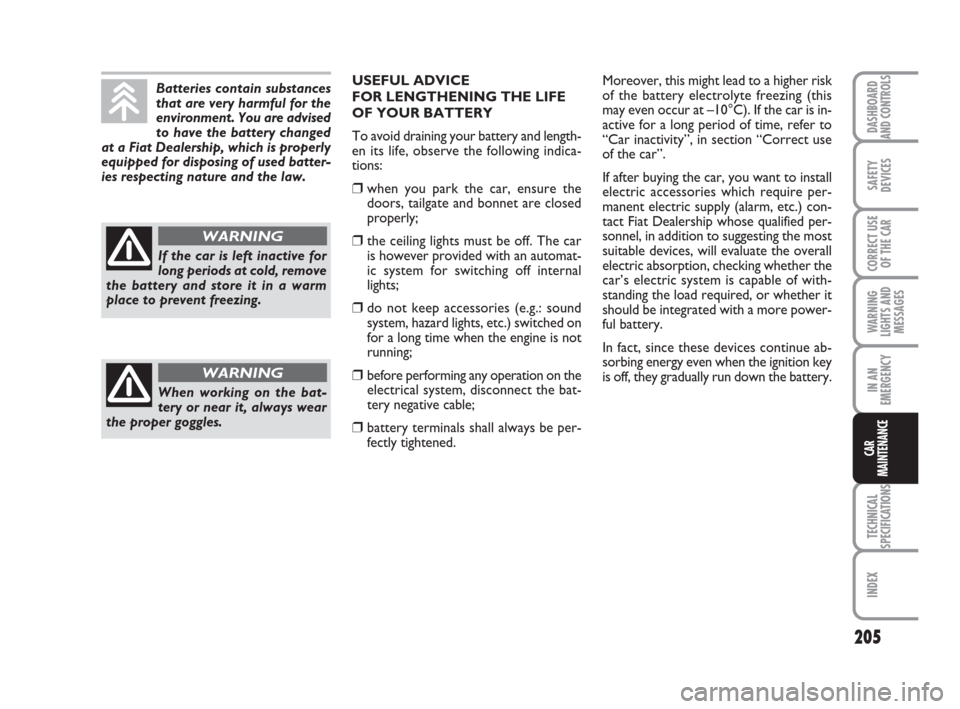
205
SAFETY
DEVICES
CORRECT USE
OF THE CAR
WARNING
LIGHTS AND
MESSAGES
IN AN
EMERGENCY
TECHNICAL
SPECIFICATIONS
INDEX
DASHBOARD
AND CONTROLS
CAR
MAINTENANCE
Batteries contain substances
that are very harmful for the
environment. You are advised
to have the battery changed
at a Fiat Dealership, which is properly
equipped for disposing of used batter-
ies respecting nature and the law.
If the car is left inactive for
long periods at cold, remove
the battery and store it in a warm
place to prevent freezing.
WARNING
When working on the bat-
tery or near it, always wear
the proper goggles.
WARNING
USEFUL ADVICE
FOR LENGTHENING THE LIFE
OF YOUR BATTERY
To avoid draining your battery and length-
en its life, observe the following indica-
tions:
❒ when you park the car, ensure the
doors, tailgate and bonnet are closed
properly;
❒ the ceiling lights must be off. The car
is however provided with an automat-
ic system for switching off internal
lights;
❒ do not keep accessories (e.g.: sound
system, hazard lights, etc.) switched on
for a long time when the engine is not
running;
❒ before performing any operation on the
electrical system, disconnect the bat-
tery negative cable;
❒ battery terminals shall always be per-
fectly tightened.Moreover, this might lead to a higher risk
of the battery electrolyte freezing (this
may even occur at –10°C). If the car is in-
active for a long period of time, refer to
“Car inactivity”, in section “Correct use
of the car”.
If after buying the car, you want to install
electric accessories which require per-
manent electric supply (alarm, etc.) con-
tact Fiat Dealership whose qualified per-
sonnel, in addition to suggesting the most
suitable devices, will evaluate the overall
electric absorption, checking whether the
car’s electric system is capable of with-
standing the load required, or whether it
should be integrated with a more power-
ful battery.
In fact, since these devices continue ab-
sorbing energy even when the ignition key
is off, they gradually run down the battery.
191-212 BRAVO GB 29-10-2008 12:33 Pagina 205
Page 207 of 246
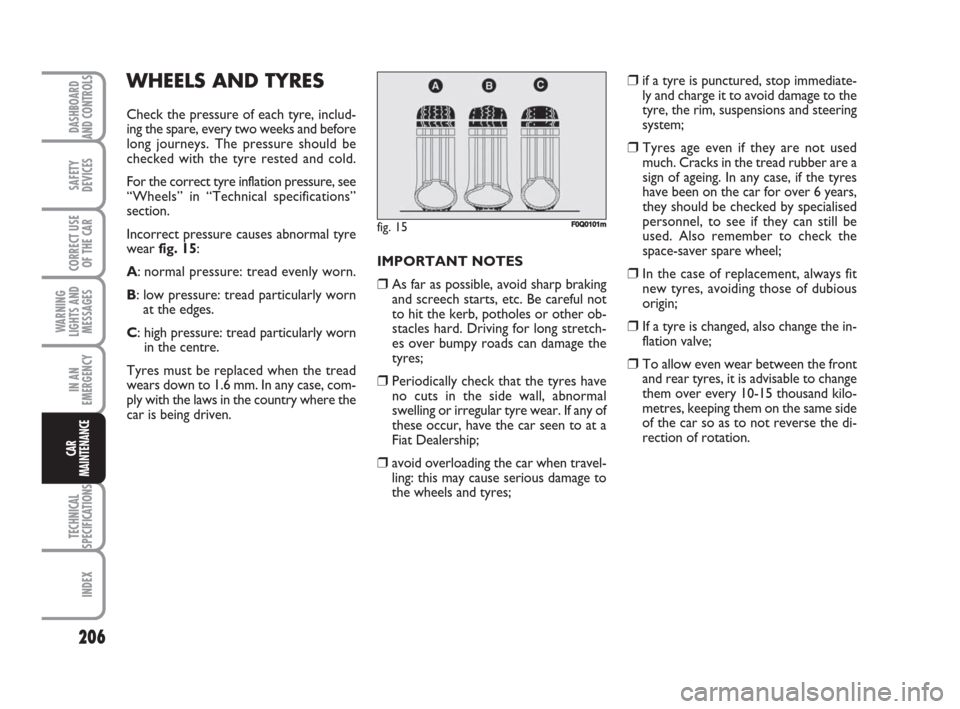
206
SAFETY
DEVICES
CORRECT USE
OF THE CAR
WARNING
LIGHTS AND
MESSAGES
IN AN
EMERGENCY
TECHNICAL
SPECIFICATIONS
INDEX
DASHBOARD
AND CONTROLS
CAR
MAINTENANCE
WHEELS AND TYRES
Check the pressure of each tyre, includ-
ing the spare, every two weeks and before
long journeys. The pressure should be
checked with the tyre rested and cold.
For the correct tyre inflation pressure, see
“Wheels” in “Technical specifications”
section.
Incorrect pressure causes abnormal tyre
wearfig. 15:
A: normal pressure: tread evenly worn.
B: low pressure: tread particularly worn
at the edges.
C: high pressure: tread particularly worn
in the centre.
Tyres must be replaced when the tread
wears down to 1.6 mm. In any case, com-
ply with the laws in the country where the
car is being driven.IMPORTANT NOTES
❒ As far as possible, avoid sharp braking
and screech starts, etc. Be careful not
to hit the kerb, potholes or other ob-
stacles hard. Driving for long stretch-
es over bumpy roads can damage the
tyres;
❒ Periodically check that the tyres have
no cuts in the side wall, abnormal
swelling or irregular tyre wear. If any of
these occur, have the car seen to at a
Fiat Dealership;
❒avoid overloading the car when travel-
ling: this may cause serious damage to
the wheels and tyres;
fig. 15F0Q0101m
❒if a tyre is punctured, stop immediate-
ly and charge it to avoid damage to the
tyre, the rim, suspensions and steering
system;
❒ Tyres age even if they are not used
much. Cracks in the tread rubber are a
sign of ageing. In any case, if the tyres
have been on the car for over 6 years,
they should be checked by specialised
personnel, to see if they can still be
used. Also remember to check the
space-saver spare wheel;
❒ In the case of replacement, always fit
new tyres, avoiding those of dubious
origin;
❒ If a tyre is changed, also change the in-
flation valve;
❒To allow even wear between the front
and rear tyres, it is advisable to change
them over every 10-15 thousand kilo-
metres, keeping them on the same side
of the car so as to not reverse the di-
rection of rotation.
191-212 BRAVO GB 29-10-2008 12:33 Pagina 206
Page 208 of 246
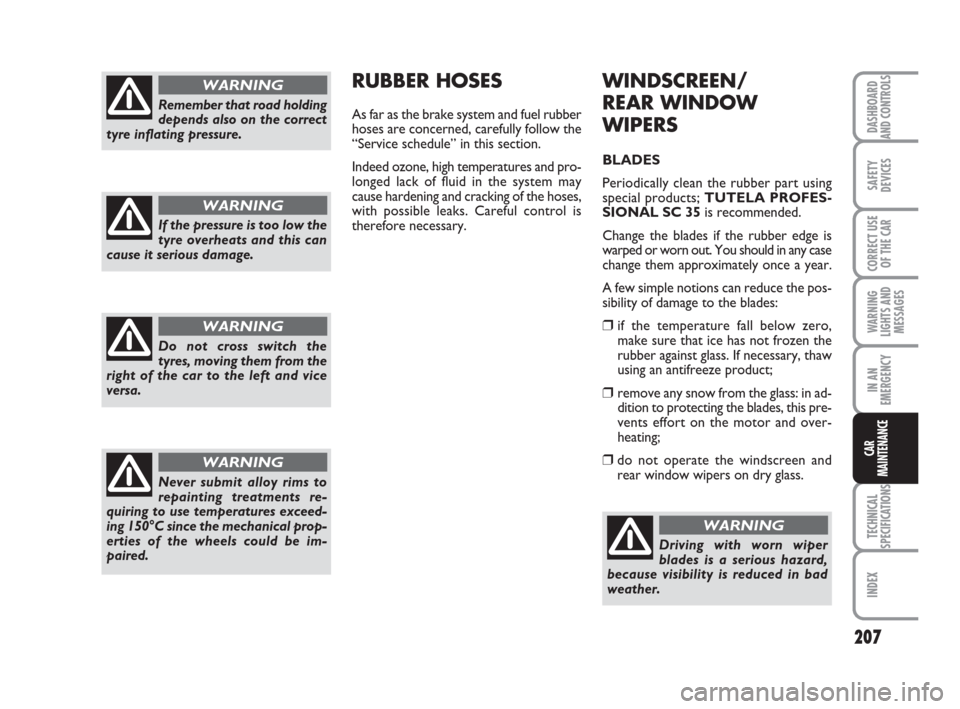
207
SAFETY
DEVICES
CORRECT USE
OF THE CAR
WARNING
LIGHTS AND
MESSAGES
IN AN
EMERGENCY
TECHNICAL
SPECIFICATIONS
INDEX
DASHBOARD
AND CONTROLS
CAR
MAINTENANCE
Remember that road holding
depends also on the correct
tyre inflating pressure.
WARNING
If the pressure is too low the
tyre overheats and this can
cause it serious damage.
WARNING
Do not cross switch the
tyres, moving them from the
right of the car to the left and vice
versa.
WARNING
Never submit alloy rims to
repainting treatments re-
quiring to use temperatures exceed-
ing 150°C since the mechanical prop-
erties of the wheels could be im-
paired.
WARNING
RUBBER HOSES
As far as the brake system and fuel rubber
hoses are concerned, carefully follow the
“Service schedule” in this section.
Indeed ozone, high temperatures and pro-
longed lack of fluid in the system may
cause hardening and cracking of the hoses,
with possible leaks. Careful control is
therefore necessary.
WINDSCREEN/
REAR WINDOW
WIPERS
BLADES
Periodically clean the rubber part using
special products; TUTELA PROFES-
SIONAL SC 35is recommended.
Change the blades if the rubber edge is
warped or worn out. You should in any case
change them approximately once a year.
A few simple notions can reduce the pos-
sibility of damage to the blades:
❒ if the temperature fall below zero,
make sure that ice has not frozen the
rubber against glass. If necessary, thaw
using an antifreeze product;
❒ remove any snow from the glass: in ad-
dition to protecting the blades, this pre-
vents effort on the motor and over-
heating;
❒do not operate the windscreen and
rear window wipers on dry glass.
Driving with worn wiper
blades is a serious hazard,
because visibility is reduced in bad
weather.
WARNING
191-212 BRAVO GB 29-10-2008 12:33 Pagina 207
Page 209 of 246
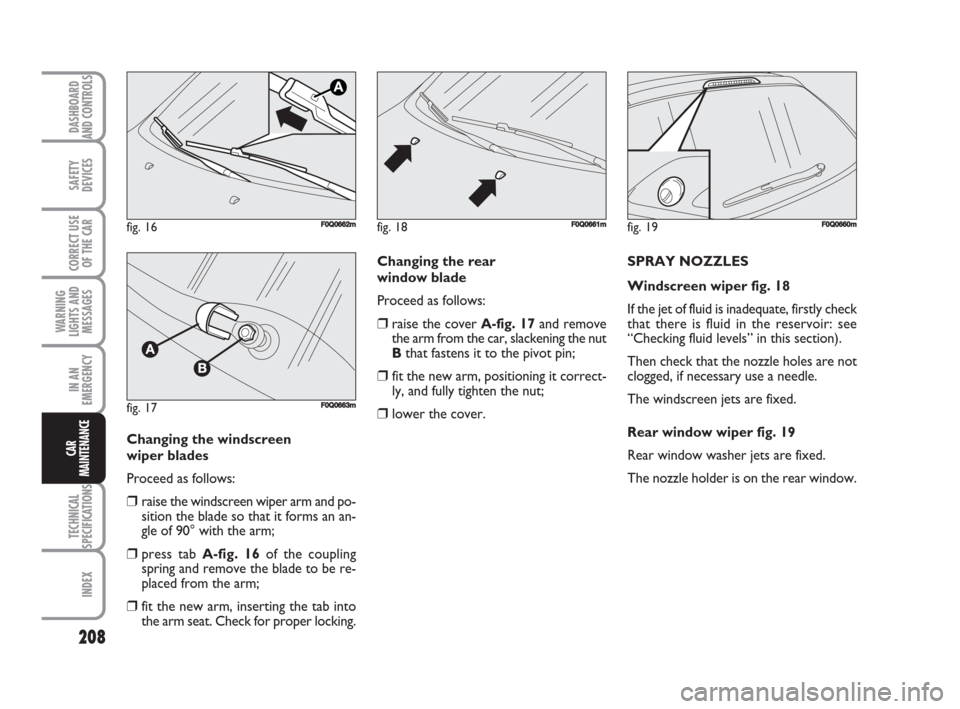
208
SAFETY
DEVICES
CORRECT USE
OF THE CAR
WARNING
LIGHTS AND
MESSAGES
IN AN
EMERGENCY
TECHNICAL
SPECIFICATIONS
INDEX
DASHBOARD
AND CONTROLS
CAR
MAINTENANCEChanging the windscreen
wiper blades
Proceed as follows:
❒raise the windscreen wiper arm and po-
sition the blade so that it forms an an-
gle of 90° with the arm;
❒press tab A-fig. 16of the coupling
spring and remove the blade to be re-
placed from the arm;
❒fit the new arm, inserting the tab into
the arm seat. Check for proper locking.
fig. 16F0Q0662m
Changing the rear
window blade
Proceed as follows:
❒raise the cover A-fig. 17and remove
the arm from the car, slackening the nut
Bthat fastens it to the pivot pin;
❒ fit the new arm, positioning it correct-
ly, and fully tighten the nut;
❒ lower the cover.SPRAY NOZZLES
Windscreen wiper fig. 18
If the jet of fluid is inadequate, firstly check
that there is fluid in the reservoir: see
“Checking fluid levels” in this section).
Then check that the nozzle holes are not
clogged, if necessary use a needle.
The windscreen jets are fixed.
Rear window wiper fig. 19
Rear window washer jets are fixed.
The nozzle holder is on the rear window.fig. 17F0Q0663m
fig. 18F0Q0661mfig. 19F0Q0660m
191-212 BRAVO GB 29-10-2008 12:33 Pagina 208
Page 210 of 246
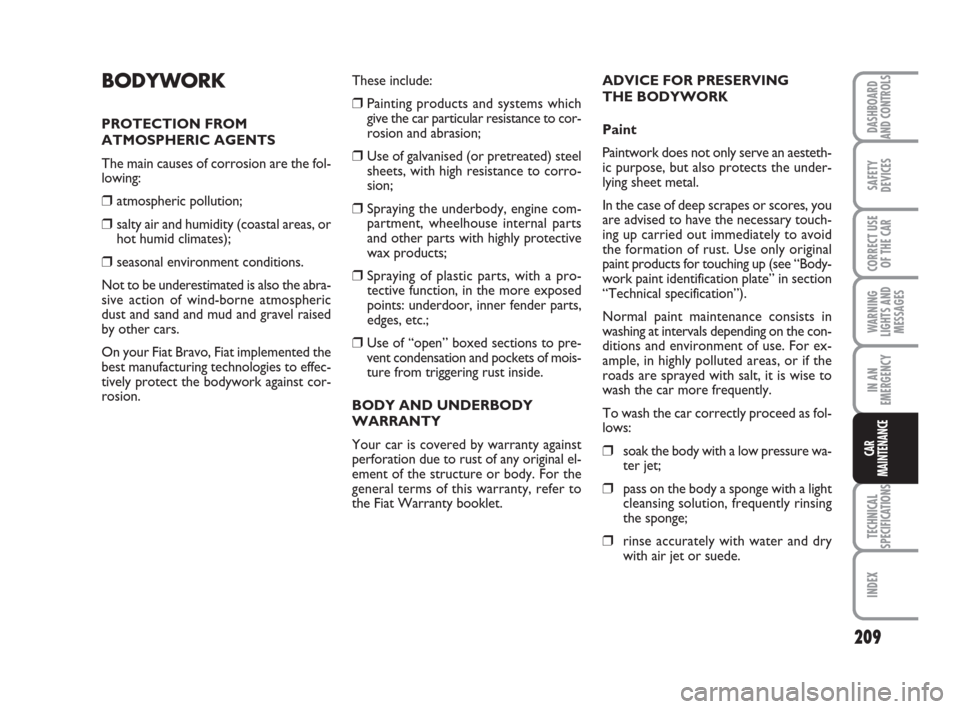
209
SAFETY
DEVICES
CORRECT USE
OF THE CAR
WARNING
LIGHTS AND
MESSAGES
IN AN
EMERGENCY
TECHNICAL
SPECIFICATIONS
INDEX
DASHBOARD
AND CONTROLS
CAR
MAINTENANCE
BODYWORK
PROTECTION FROM
ATMOSPHERIC AGENTS
The main causes of corrosion are the fol-
lowing:
❒ atmospheric pollution;
❒ salty air and humidity (coastal areas, or
hot humid climates);
❒ seasonal environment conditions.
Not to be underestimated is also the abra-
sive action of wind-borne atmospheric
dust and sand and mud and gravel raised
by other cars.
On your Fiat Bravo, Fiat implemented the
best manufacturing technologies to effec-
tively protect the bodywork against cor-
rosion.These include:
❒ Painting products and systems which
give the car particular resistance to cor-
rosion and abrasion;
❒ Use of galvanised (or pretreated) steel
sheets, with high resistance to corro-
sion;
❒ Spraying the underbody, engine com-
partment, wheelhouse internal parts
and other parts with highly protective
wax products;
❒ Spraying of plastic parts, with a pro-
tective function, in the more exposed
points: underdoor, inner fender parts,
edges, etc.;
❒Use of “open” boxed sections to pre-
vent condensation and pockets of mois-
ture from triggering rust inside.
BODY AND UNDERBODY
WARRANTY
Your car is covered by warranty against
perforation due to rust of any original el-
ement of the structure or body. For the
general terms of this warranty, refer to
the Fiat Warranty booklet.ADVICE FOR PRESERVING
THE BODYWORK
Paint
Paintwork does not only serve an aesteth-
ic purpose, but also protects the under-
lying sheet metal.
In the case of deep scrapes or scores, you
are advised to have the necessary touch-
ing up carried out immediately to avoid
the formation of rust. Use only original
paint products for touching up (see “Body-
work paint identification plate” in section
“Technical specification”).
Normal paint maintenance consists in
washing at intervals depending on the con-
ditions and environment of use. For ex-
ample, in highly polluted areas, or if the
roads are sprayed with salt, it is wise to
wash the car more frequently.
To wash the car correctly proceed as fol-
lows:
❒soak the body with a low pressure wa-
ter jet;
❒pass on the body a sponge with a light
cleansing solution, frequently rinsing
the sponge;
❒rinse accurately with water and dry
with air jet or suede.
191-212 BRAVO GB 29-10-2008 12:33 Pagina 209